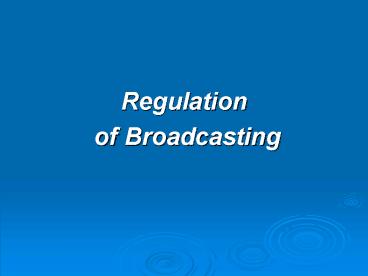Regulation - PowerPoint PPT Presentation
1 / 13
Title:
Regulation
Description:
1. Scarcity of Airwaves the Original Basis for Regulation --1927 and 1934 laws establish federal ... FCC punishes broadcast hoaxes that endanger public safety ... – PowerPoint PPT presentation
Number of Views:434
Avg rating:3.0/5.0
Title: Regulation
1
- Regulation
- of Broadcasting
2
- A. Regulation Why and How?
- 1. Scarcity of Airwaves the Original Basis for
Regulation - --1927 and 1934 laws establish federal licensing
- --Scarce resource doctrine and regulatory power
upheld in NBC v. U.S. (1943)
3
- 2. Does Scarcity Rationale Make Sense Today? If
Not, Why Regulate? - --Alternative reasons for regulation
- --Broadcasting has been substantially deregulated
since 1980
4
- 3. Broadcast (and Telecom) Policy Made through
Interplay of Several Groups and Institutions - --The Federal Communications Commission (FCC)
plays a central role - --The other players in shaping policy?
5
- 3. Broadcast (and Telecom) Policy Made through
Interplay of Several Groups and Institutions
contd - --The other players in shaping policy?
6
- 4. FCCs Basic Regulatory Power is Licensing
- --Ownership qualifications
- --Limits on ownership
- --Licensees now selected through auction
- --Licenses routinely renewed
7
- B. Content Regulations
- 1. Law Supposedly Denies FCC the Power to Censor
Broadcasting, But. . . - 2. Political Candidates Must Have Reasonable,
Equal Access - --What's reasonable access?
8
- 2. Political Candidate Rules contd
- --Equal opportunities for opposing candidates
- 3. With Deregulation, Theres Little Legally
Required Fairness in News and Public Affairs
9
- 4. Law Forbids Broadcast Obscenity, Limits
Indecency - --Sup. Ct. upheld indecency as standard for
broadcasting in FCC v. Pacifica (1978)
10
- --Struggle over a safe harbor for broadcast
indecency - 1978--Pacifica decision
- 1987--FCC says indecent programming can only be
aired after midnight - 1988--D.C. Circuit Ct. of Appeals FCC needs
evidence that midnight is the appropriate cutoff - 1989--Congress passes Helms amendment tells FCC
to ban indecency 24 hrs a day - 1990--D.C. Cir. Ct. strikes down 24 hr ban as
unconstitutional - 1991--FCC studies matter and can find no
alternative to 24 hr ban because children always
in audience - 1991--D.C. Cir. strikes down as unconstitutional
because it lacked evidence that this was
necessary to protect children (Supreme Ct.
declines to hear appeal) - 1992--Congress required FCC to restrict indecency
to midnight-6 am - 1993--three-judge panel of Cir. Ct. invalidates
1992 law says Congress and FCC need to consider
rights of all viewers, not just those of children - 1995--full Cir. Ct. rehears case says 10 pm-6 am
safe harbor ok, though FCC could modify it with
sufficient evidence.
11
- 5. Children's Programming
- --Deregulation in 1980s led to more ads on
children's programs - --1990 act re-imposed limits and obligations
- --V-chip and ratings give parents control
12
- 6. Miscellaneous Content Controls
- --No limits on the amount of advertising except
in childrens programs - --FCC punishes broadcast hoaxes that endanger
public safety - --FCC frowns on shady station promotions
- --FCC requires disclosure of payola and plugola
13
- For the next class, be prepared to discuss. .
. - Why does law lag behind -- or even delay --
the development/use of new media technologies?
There are three or four good reasons why law is
inherently conservative in this respect.































